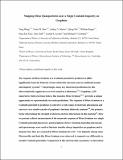| dc.contributor.author | Wang, Yang | |
| dc.contributor.author | Brar, Victor W. | |
| dc.contributor.author | Shytov, Andrey V. | |
| dc.contributor.author | Wu, Qiong | |
| dc.contributor.author | Regan, William | |
| dc.contributor.author | Tsai, Hsin-Zon | |
| dc.contributor.author | Zettl, Alex | |
| dc.contributor.author | Crommie, Michael F. | |
| dc.contributor.author | Levitov, Leonid | |
| dc.date.accessioned | 2015-08-25T18:44:35Z | |
| dc.date.available | 2015-08-25T18:44:35Z | |
| dc.date.issued | 2012-07 | |
| dc.date.submitted | 2012-02 | |
| dc.identifier.issn | 1745-2473 | |
| dc.identifier.issn | 1745-2481 | |
| dc.identifier.uri | http://hdl.handle.net/1721.1/98222 | |
| dc.description.abstract | The response of Dirac fermions to a Coulomb potential is predicted to differ significantly from how non-relativistic electrons behave in traditional atomic and impurity systems. Surprisingly, many key theoretical predictions for this ultra-relativistic regime have not been tested. Graphene, a two-dimensional material in which electrons behave like massless Dirac fermions, provides a unique opportunity to test such predictions. Graphene’s response to a Coulomb potential also offers insight into important material characteristics, including graphene’s intrinsic dielectric constant, which is the primary factor determining the strength of electron–electron interactions in graphene. Here we present a direct measurement of the nanoscale response of Dirac fermions to a single Coulomb potential placed on a gated graphene device. Scanning tunnelling microscopy was used to fabricate tunable charge impurities on graphene, and to image electronic screening around them for a Q = +1|e| charge state. Electron-like and hole-like Dirac fermions were observed to respond differently to a Coulomb potential. Comparing the observed electron–hole asymmetry to theoretical simulations has allowed us to test predictions for how Dirac fermions behave near a Coulomb potential, as well as extract graphene’s intrinsic dielectric constant: ε[subscript g] = 3.0±1.0. This small value of ε[subscript g] indicates that electron–electron interactions can contribute significantly to graphene properties. | en_US |
| dc.description.sponsorship | United States. Office of Naval Research. Multidisciplinary University Research Initiative (Award N00014-09-1-1066) | en_US |
| dc.description.sponsorship | United States. Dept. of Energy. Office of Science (Contract DE-AC02-05CH11231) | en_US |
| dc.description.sponsorship | National Science Foundation (U.S.) (Award DMR-0906539) | en_US |
| dc.language.iso | en_US | |
| dc.publisher | Nature Publishing Group | en_US |
| dc.relation.isversionof | http://dx.doi.org/10.1038/nphys2379 | en_US |
| dc.rights | Creative Commons Attribution-Noncommercial-Share Alike | en_US |
| dc.rights.uri | http://creativecommons.org/licenses/by-nc-sa/4.0/ | en_US |
| dc.source | arXiv | en_US |
| dc.title | Mapping Dirac quasiparticles near a single Coulomb impurity on graphene | en_US |
| dc.type | Article | en_US |
| dc.identifier.citation | Wang, Yang, Victor W. Brar, Andrey V. Shytov, Qiong Wu, William Regan, Hsin-Zon Tsai, Alex Zettl, Leonid S. Levitov, and Michael F. Crommie. “Mapping Dirac Quasiparticles Near a Single Coulomb Impurity on Graphene.” Nature Physics 8, no. 9 (July 29, 2012): 653–657. | en_US |
| dc.contributor.department | Massachusetts Institute of Technology. Department of Physics | en_US |
| dc.contributor.mitauthor | Levitov, Leonid | en_US |
| dc.relation.journal | Nature Physics | en_US |
| dc.eprint.version | Original manuscript | en_US |
| dc.type.uri | http://purl.org/eprint/type/JournalArticle | en_US |
| eprint.status | http://purl.org/eprint/status/NonPeerReviewed | en_US |
| dspace.orderedauthors | Wang, Yang; Brar, Victor W.; Shytov, Andrey V.; Wu, Qiong; Regan, William; Tsai, Hsin-Zon; Zettl, Alex; Levitov, Leonid S.; Crommie, Michael F. | en_US |
| dc.identifier.orcid | https://orcid.org/0000-0002-4268-731X | |
| mit.license | OPEN_ACCESS_POLICY | en_US |
| mit.metadata.status | Complete | |
